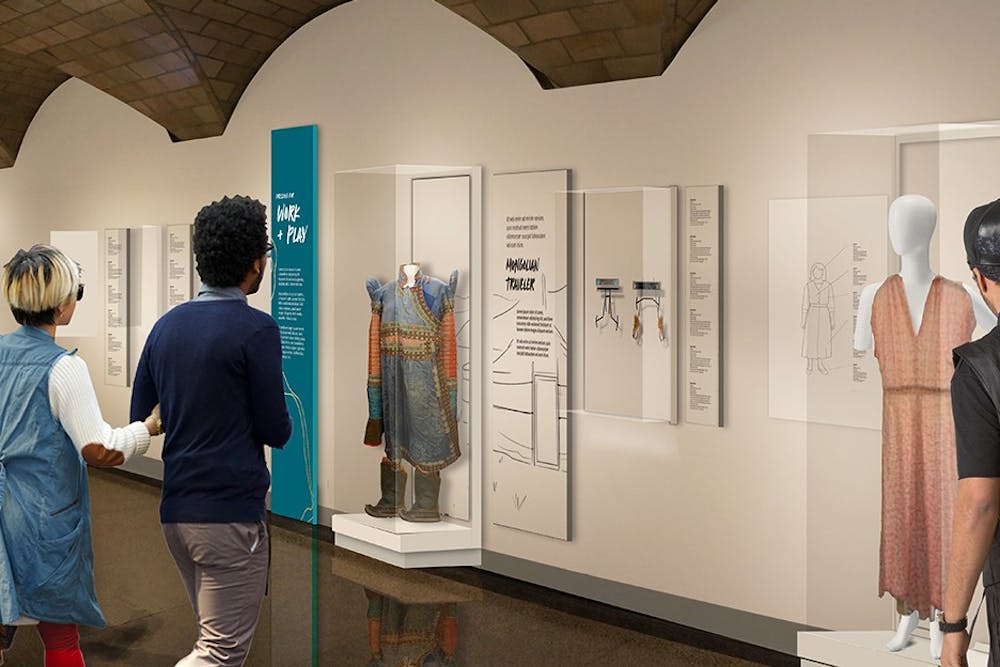The Penn Museum is opening a new exhibit on the meaning behind clothing and fashion as a celebration of apparel and accessories across cultures spanning a 2,500-year period.
The exhibit — titled "The Stories We Wear" — is set to open on Sept. 25 and was curated by Anthropology professor Lauren Ristvet and two other anthropologists at the Museum. It will be available for nine months until June 12, 2022, and can be accessed by the public through general admission to the Museum or free for Penn students, faculty, and affiliates.
The exhibition will host 250 different objects — from armor to jewelry to tattoos — that were selected from the Museum’s collections or borrowed from local organizations and individuals, including the National Marian Anderson Museum & Historical Society and the Robert and Penny Fox Drexel Historic Costume Collection.
The objects in "The Stories We Wear" were organized around five themes: Performance, Ceremony, Battle, Work and Play, and Rule, according to the press release. Each of the themes featuring a range of artifacts or related objects.
The artifacts housed within the exhibit range from a 19th-century Qing dynasty carved coral statue to a contemporary drag costume from Philadelphia-based drag queen Eric Jaffe, the curators said. Other notable items in the collection to expect to see include armor constructed from coconut fiber, a gold and emerald pendant used in the burial of a Coclé chief, and the full ensemble of a Hopi bride from the early 20th century.
Ristvet said that "The Stories We Wear" was inspired by a previous Penn Museum exhibition dating back to the 1940s during the Second World War called "Five Thousand Years of Vanity." The previous exhibit explored clothing and accessories as “frivolous” or nonessential, but Ristvet said that in curating the 2021 exhibit, she and her colleagues intended to do the opposite.
“So what we wanted to do instead was to think about the subject that we have been so inculcated to think of as being absolutely the least important thing in our life and show why it mattered,” she said.
According to 2018 Archeology Ph.D. graduate Sarah Linn, a research liaison at the Penn Museum and one of the exhibit’s curators, the themes are intended to “introduce visitors to this idea that what we put on our bodies helps shape who we are.”
RELATED:
Penn astronomers discover largest comet in modern history that will be visible in 2031
Nine fellows selected as 2021 Provost’s Postdoctoral Fellows for Academic Diversity
Linn drew attention to the juxtaposition employed in the exhibit, saying that it was deliberate.
“We’re really pulling from a lot of different contexts, from different individuals, from different time periods, from different places," she said.
She said the curators also felt it was important to include “hyper-local” items highlighting Philadelphia culture along with global artifacts, in order to “put [the] collections in dialogue with more contemporary stories and more local stories.”
The exhibit curators hoped to engage visitors through interactive components. Visitors are encouraged to post and share stories about their tattoos, keepsakes, heirlooms, clothing, or jewelry on social media. Individuals can tag Penn Museum's social media, use the hashtag #StoriesWeWear, or email the Museum for the opportunity to be featured in the exhibit in the future.
2008 Anthropology Ph.D. graduate Jane Hickman, one of the curators and a consulting scholar at the Penn Museum, described the importance of connecting to viewers and what displaying such material communicates to a contemporary audience.
“We want people to see that the decisions they make about the clothing they wear and the jewelry they wear is deliberate and there is some meaning to that,” Hickman said.









